What is EDI? In it’s simplest form EDI can be defined as the transfer of structured data, by agreed message standards, from one computer system to another without human intervention. In essence, it provides the structure necessary for computers to exchange information with one another.
Probably the best way to think of Electronic Data Interchange is to consider it in terms of what it strives to replace, which is the circulation of paper documents.
In a system based on paper when one entity wants to pass a piece of information to another, the information has to first be collated in the form of a written document. This task requires a person on the sending end to first “encode” the information in the form of a document and produce it. Another person on the receiving end then takes the document, reads it, ideally understands it and routes the piece of information appropriately. In order for the person who receives the document to be able to understand the message, the document needs to follow a set of naming and formatting conventions and needs to be created to a certain level of eligibility.
The exchange of information as described above is exactly what EDI strives to augment via the employment of electronic means. The end result is that a message can be transmitted between two parties, appropriately processed on the receiving end, with all of the information exchange happening without the involvement of a human being. In this paradigm of communication human intervention is intended for quality review and for special situations. As we will see later on, this poses various additional requirements on the format of the document and methods of transmission but also offers several significant benefits that in many cases outweigh the costs by a large margin.
In order to understand Electronic Data Interchange better let us take a look at how it all began.
Today, EDI solutions are used across diverse industry verticals to streamline business processes while attaining flexibility and agility at the same time.
A bit of history
Like many other inventions in human history, the onset of this technology was inspired by conflict. The great Berlin airlift was a massive logistical operation of unparalleled scale and complexity (200 000 flights in a year, over 4700 tons of necessities delivered daily!). To facilitate the transportation of goods an enormous amount of information had to be tracked and managed. Soon enough the old paradigm of exchanging information via writing it down on paper started to reach its limits and had to be supplemented. Simply put, people were no longer able to document and process the information at an adequate pace given the scale of the operation. Enter technology. Many of the concepts experimented with here were later refined and are in use till this day (integrated systems, direct trader input methods, etc).
What are the benefits of EDI?
This technology offers several key advantages over paper systems:
Cost savings in three main areas:
- Reduction of human interactions necessary to sustain information flow
- No need for manual entry
- Less paper documents produced
Reduction in errors which allows for further cost reductions
Increased speed of processing:
- Reduces cycle times which can translate into competitive advantage from products reaching the market sooner
- Better understanding of corporate cost structure
- Key component of just-in-time production systems
Barriers to implementation
“Ok”, you may ask, “but if this technology seems to be that great, why isn’t everyone using it?” Here the answer is a bit more complex. Back in the early eighties and earlier this technology was available only to enterprises who could afford mainframe computers. That was a major limiting factor and it was not even that long ago, only 30 years.
Even as computer infrastructure was becoming more affordable it still took many companies a whole lot of time to bring their infrastructure to a level which could facilitate the execution of Electronic Data Interchange. Companies were forced to rely on paper documents to execute business processes and the practice of handling everything via paper has become deeply ingrained into many organizations. Further to that, over the years of this practice many organizations developed business processes that are so intricate that a move to a standardized industry best practice becomes quite a complex undertaking.
Even if a business operates in a straightforward, transparent, well defined manner that lends itself well to incorporating information flow based on standards, there still is a significant set-up cost both in time and money. The preliminary expenses of implementation, customization and training can seem prohibitive in the perception of stakeholders.
Another significant consideration is that good implementation of this technology is not an easy feat. Approaching the transition without fully understanding the implications of how deep this technology affects the DNA of an organization can have dire consequences.
On top of that the level of implementation needs to be aligned with the size of the company. That is the key ingredient. A multinational car manufacturer with markets on several continents will have completely different needs than a local producer of dairy who now would like to start selling their product to Walmart. Inappropriately selecting the level of implementation might result in increased set-up costs, longer implementation time and even in an ongoing risk to the business.
Benefits of EDI
EDI might be a great technology in it’s own right, but it is the benefits of EDI that drive it’s adoption. What are some of the key benefits that convinced over 60% of US firms with over 5 000 employees to adopt this technology and how can it help your organization?
Cost Savings
If there is one thing that works well as a convincing factor in the business world, that for sure is the promise of cost reduction. I would argue that when it comes to the benefits of Electronic Data Interchange there are other considerations that are equally if not more important, but for the sake of having to start somewhere let us first take a closer look at the cost reduction opportunities that this technology offers. As we rid our business environment of paper documents the costs of personnel, supplies, office and storage space diminish. Costs generated by handling paper are likely greater than we might initially think. Printing, copying, postage, storage and document retrieval – all those costs can be reduced significantly or eliminated completely. In fact, the switch to handling documents electronically has a ripple effect consequences of which many are often not apparent at first sight. Let’s take a closer look for example at the effects of significant reduction in printing. The first level of cost savings is easy to notice – lower cost of printing supplies. But the reduced tear and wear of document imagers also has an associated positive monetary value. The reduced frequency at which our personnel has to order and replace toners also results in conserved resources. Overall EDI reduces the complexity of document flow which can offer significant cost savings in many areas but as we will see this is by far not the most exciting aspect of this technology.
Improved Data Quality
Most data errors arise during keying in of data from a paper document into company’s internal system. Those errors arise both when dealing with handwritten and printed documents, though resolving to printing does offer some help in this regard. EDI takes us a step further and enables better data integrity by business critical information being fed automatically into internal systems rather then it having to undergo the very error prone, labor intensive process of being manually re-keyed. What does improved data quality mean for an organization? The likelihood of overpayments, late or underpayments which all can result in additional fees is greatly reduced. The risk of losing business due to delays is also diminished. Very importantly, the organization is now in a position to offer better customer service thus projecting a more positive image which can help with customer retention and increasing market share. Improved data quality is definitely important, but we still have not gotten to uncover the full potential of Electronic Data Interchange. The next aspect that we will discuss is quite significant but I am saving the best for last :).
Improved Data Security
The next benefit of EDI is that it makes the holy grail of data security possible – we now have an end to end audit trail and are able to detect and prevent tampering of data. Further to that, storing documents electronically allows us to control with greater granularity who has access to what information. The great risk that is posed by documents with important information being scattered around the office is now greatly reduced. Another thing to keep in mind here is that this technology allows for internal and external audits to be carried out in a much quicker and more cost efficient manner. We all know how important audits are in today’s business reality and how pricey the time of an auditor can be. Thanks to EDI we now can use the latter to full potential while at the same time maintaining better control of audit scope.
Strategic Business Benefits
Electronic Data Interchange goes deep and transforms organizational DNA. It forces us to take a closer look at our business and to reexamine many things we take for granted. It also provides the healthy backbone a business needs to connect with other modern technologies. Specifically, EDI makes real time visibility into business processes a reality. This makes possible for unparalleled responsiveness and much faster decision making. Thanks to now having access to cold, hard data we are able to pick up on changing conditions much sooner and are able to augment our strategic decision making with adequate information. The value of this to a business cannot be overestimated. Another very important strategic benefit that this technology grants is the ability to move towards a demand-driven business model. This shortens the lead times, enhance ability to enter new markets and helps in interacting with other organizations who are opting for a similar approach (and which business wouldn’t if it had the choice). Probably most importantly of all, EDI opens up an opportunity for cultural change. You heard it right. The mythical unicorn that so many organizations are after but that is so hard to tame. Through the implementation of EDI staff moves from re-keying of information (and thus taking little to no ownership of the process) to someone playing the role of a supervisor, managing and improving the process and manually intervening only when a critical condition arises. This is key. This opens grounds to a completely new ball game – one where instead of having an army of people performing the proverbial “ctrl+c ctrl+v” all day long, chances are you now have a smaller head count but now they are doing real value add work. This is the true power of EDI that an organization needs to harness in order to maintain its competitive edge.
Summary of the benefits of EDI
To summarize, we have taken a closer look at some of the benefits that EDI has to offer. The main benefits are as follow:
- Significant cost reductions
- Improved data quality
- Improved data security and ability to carry out audits in a cost efficient manner
- Significant strategic benefits that can translate to competitive advantage
- An ability to transform organizational DNA and positively affect its culture
EDI Standards
As a lead in to the discussion on EDI standards, let us first consider what an EDI document is. An EDI document is simply an electronic version of a paper document! This sounds simple – and indeed it is! – but there are some quite unintuitive consequences of this transition from paper to electronic means.
If an EDI document is just an electronic version of a paper document, why don’t we just digitize a paper document, feed it into the computer, have it work its magic and be done with it? That indeed would be ideal, but unfortunately this is not possible given the current state of computing.
There are many things that computers absolutely excel at like crunching numbers, storing videos and music, but there are also areas in which we humans greatly outperform even the fastest computers in the world. One such area is pattern recognition – when we look at a scene we are able to identify in nearly real time that a particular set of lines and shapes constitutes a door, a cat, or a chandelier, whereas for a computer even to identify that an animal is in a picture it is being shown is no easy task.
To put it mildly, computers by their very nature are not very good at recognizing patterns. This is changing and some great progress has been made recently, but humans still outperform computers in this regard very significantly. Thus, if we have a document, let’s say an invoice, a person can look at it and identify the VAT number, can decipher where the inventory list is and where individual counts are even if they have not seen exactly an invoice like this particular one before. We can generalize past experience to understand novel situations whereas the abilities of computers are still very limited in this regard.
This is where standards come into play. Standards provide a set of rules that tell a computer what information it may expect to see in a document of a particular type and how the information will be presented. They also define the shape and form of the document very clearly so that a computer doesn’t have to employ pattern recognition at all in order to extract meaning. All it needs to do is follow the rules it was provided with, look in specific places of the document and extract the information it expects to see. The next step is to feed the extracted information into internal systems and document transfer is complete! Simple!
With this knowledge under our belt understanding the significance of EDI standards becomes easy! A standard defines the syntax and semantics of document exchange, it defines how information is encapsulated in a document and later transferred and read on the receiving end of electronic communication.
In short a standard is nothing more than a set of rules that we can construct our EDI system to adhere to. If we look at an EDI standard to be like a language, implementing our EDI system to follow a particular standard would allow our organization to communicate with other entities who have an EDI system speaking the same language! And this is where the whole magic of EDI standards come in to play. By aligning our EDI system with a particular standard our organization is now in a position to exchange documents electronically with other entities who can speak the same EDI language.
What Are The Most Common EDI Standards
The two most popular EDI standards are ANSI X12 and UN/EDIFACT.
ANSI X12 is developed and maintained by The Accredited Standards Committee X12 (also known as ASC X12). It was chartered by the American National Standards Institute (ANSI) in 1979 and upon formation included representatives from transportation, government and computer manufacturer industries. ANSI X12 EDI is used by more than 300, 000 companies worldwide and the ASC X12 also contributes to development of the second standard I mention above, the UN/EDIFACT.
The Electronic Data Interchange for Administration, Commerce and Transportation (EDIFACT) was developed under the auspices of the United Nations. It is the most common standard used by European businesses today.
Both of the standards mentioned above have several subsets and define hundreds if not thousands of business documents. To give you a better idea of what sort of documents those are, let me list below a few that are among the most frequently used.
Product Catalog (832/PRICAT)
This is a document that a supplier shares with its customers. It contains a list of available products and services along with information such as item description, price and availability. This document allows a buyer to issue a purchase order directly against an item from the catalog. This document is very popular in the retail industry.
Purchase Order (850/ORDERS)
This is your usual purchase order but in electronic form. It specifies what goods are being purchased and defines the conditions of the trade.
Purchase Order Acknowledgment (855/ORDERSP)
A supplier issues this document to confirm to the buyer that his order will be fulfilled as requested.
Invoice(810/INVOIC)
Invoice but in electronic form – a request for payment for goods or services.
Advance Ship Notice (856/DESADV)
A packing slip but in electronic form that tells a buyer that goods have been shipped, provides information on how they have been packed and estimates arrival time. Many automated business processes (for example drop shipping and just in time delivery) rely heavily on this document.
EDI Solutions – How to Connect to Your Business Partners
What are the communication options an organization can chose from in order to partake in the exchange of EDI documents with its business partners? Having an understanding of available EDI solutions in this space is crucial as picking an inadequate communication channel can turn out to be a very costly mistake.
Given the richness of the Electronic Data Interchange field there is a sky high number of combinations of technologies an organization can opt for, however thankfully all solutions can be characterized as belonging to one of three models. In paragraphs to follow I will provide a brief overview of each of those three EDI solutions along with a discussion of their pros and cons.
Direct Connection Model
This probably is the simplest model to describe, yet in many cases it is also the most complicated one for an organization to implement. In this approach an organization reaches out on its own to each of its partners and establishes a direct communication channel. One might be under the impression that this solution is very simple, however if we take into account the number of communication protocols our partners might utilize, the situation becomes very complex very quickly.
Just to list some of the most common protocols, we have AS2, SFTP, FTPS, FTP and FTP/VPN. On top of this, each protocol provides numerous configuration options that can be set. Thus an organization that chooses this EDI solution would need to purchase a software package that would enable it to use all the agreed upon protocols. Further to that, a significant amount of configuration work would need to be performed to set up each communication channel.
All this makes the implementation of this model of communication rather complex. Not only do we need to face significant set up costs but further to that we need to maintain an ability to manage those communication channels over time. As such, this model is usually only selected by the largest of organizations for reasons explained below.
Network Model
In the network model of Electronic Data Interchange an organization communicates with its business partners solely through an EDI Network Services Provider (in pre-Internet days they were referred to as Value-Added Networks or simply VANs). This is an approach that many businesses utilize in order to remove some of the complexity faced when implementing direct communication channels.
In this model an organization has just a single connection that goes out to the provider. It can utilize any protocol that the business in question prefers. The provider than does the work of connecting us to our partners and translating from our preferred protocol to that of theirs.
This removes much of the complexity however comes at a monetary cost – we simply need to pay for the services provided by the third party. We still are required to generate and process all EDI documents that we exchange, however we no longer need the worry about how the documents get from us to our business partners.
One could be inclined at this point to ask the question – which model of information exchange is best? The answer is, it depends. Do not lose all hope yet however! Within next couple of sentences we will be able to make sense of it all and will obtain a mechanism for making an educated choice based on our organization’s needs.
In summary, the direct communication model can offer very low per document cost when many documents are exchanged with a single business partner. On the other hand, the Network Model outsources much of the complexity of setting up communication channels. This can be very useful if we have many business partners we would like to talk to. A third party can provide us with the know how necessary to deal with such a situation both effectively and efficiently.
The hybrid model
In this paradigm of communication exchange an organization establishes direct communication channels with its business partners with whom they exchange a high volume of documents, leaving their connection with low volume (and often numerous) business partners to be managed by an EDI Network Services Provider.
A3LOGICS
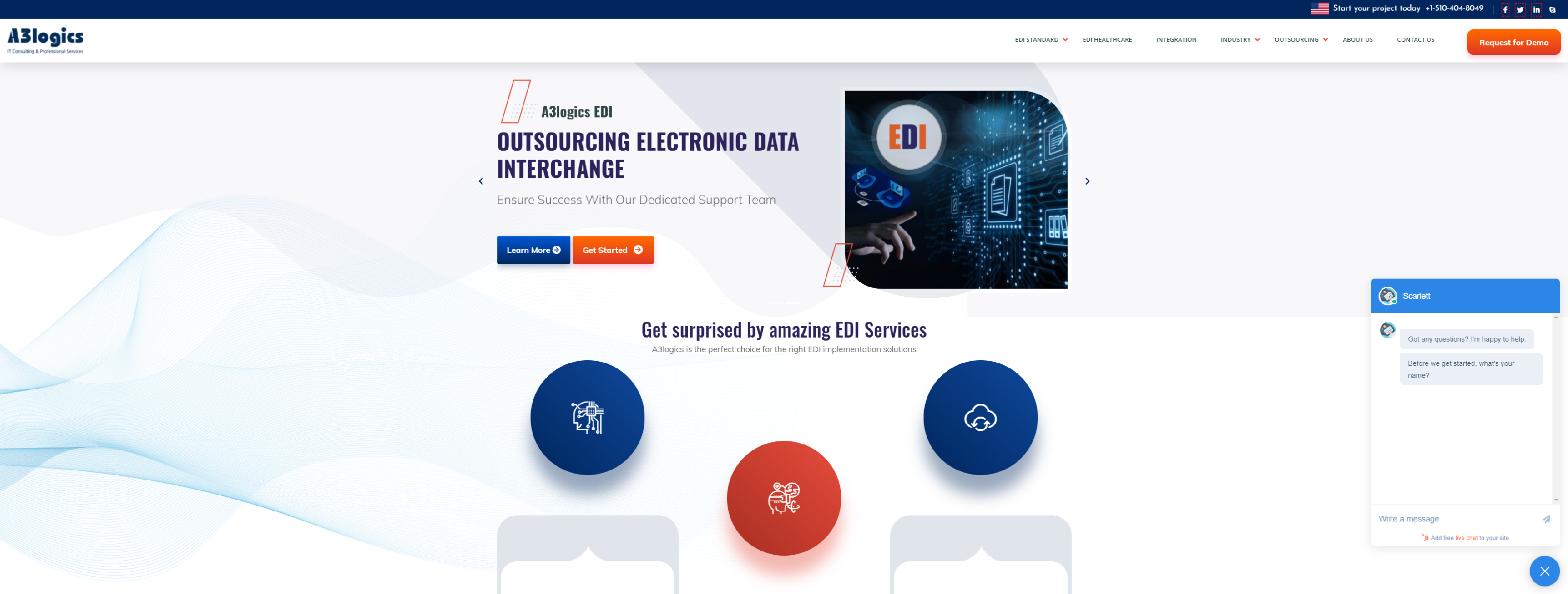
Proactive and reliable. With A3logics flexible EDI integration services accelerate your business growth with uninterrupted connectivity…
- Meet business demands with Mobile EDI, Direct EDI, & Indirect EDI Integration.
- Deep analysis and a clear roadmap to integration with EDI consulting.
- Connecting trading partners for smooth communication.
- Offer wide EDI integration and implementation services, ensuring compliance.
- Managing technical factors such as API for seamless B2B and EDI integration.
FLOWSOFTWARE
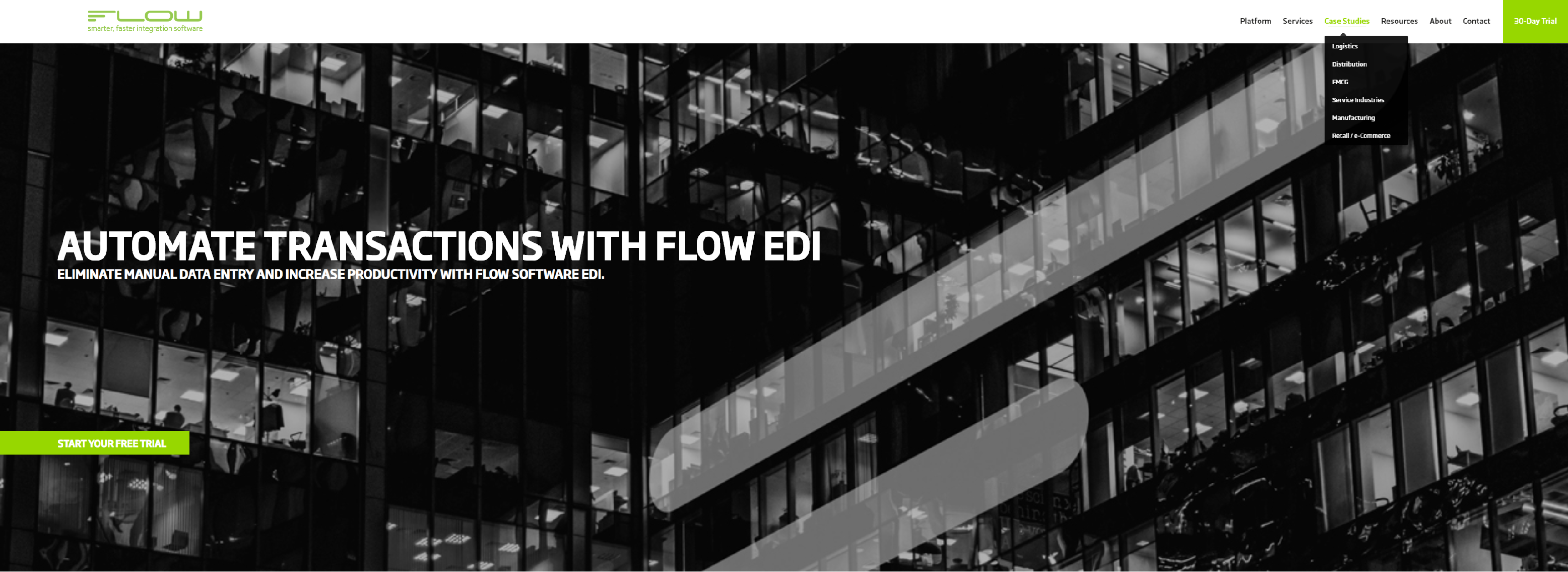
Integrate your apps. Automate your business. Our Flow Integration and B2BG EDI Software turns your existing systems into a multi-channel B2B/B2C eCommerce and EDI solution.
- Automating business processes eliminates manual data entry and improves data accuracy
- Flow EDI enables efficient stock management. Orders flow electronically into your suppliers’ ERP system generating a purchase order response automatically advising of stock availability and delivery date
- EDI provides real-time automated data transfer between trading partners
- Reduce the order-to-cash cycle time whilst improving data quality and relationships with trading partners
- Flow EDI eliminates manual processing and the associated back office costs and reduces warehouse inefficiencies
- Empower staff to add increased value to customer experience and build stronger business relationships
DATAMASONS

Data Masons provides Certified EDI Integration for Microsoft Dynamics including Dynamics 365, Dynamics AX, Dynamics GP and Dynamics NAV, and Macola.
- Vantage Point EDI Overview
- Purchase Orders
- Invoices
- Advanced Ship Notice – ASN
- Planning Schedule – Planning Schedule Release
- Supply Chain EDI – Supplier Facing
- Remote Warehouse Integration
- Transportation Management System
- PO Acknowledgement System
- Product Activity
- Product Catalog
- VAN Service
- Universal Data Translator
- Other EDI Transactions
CLEO
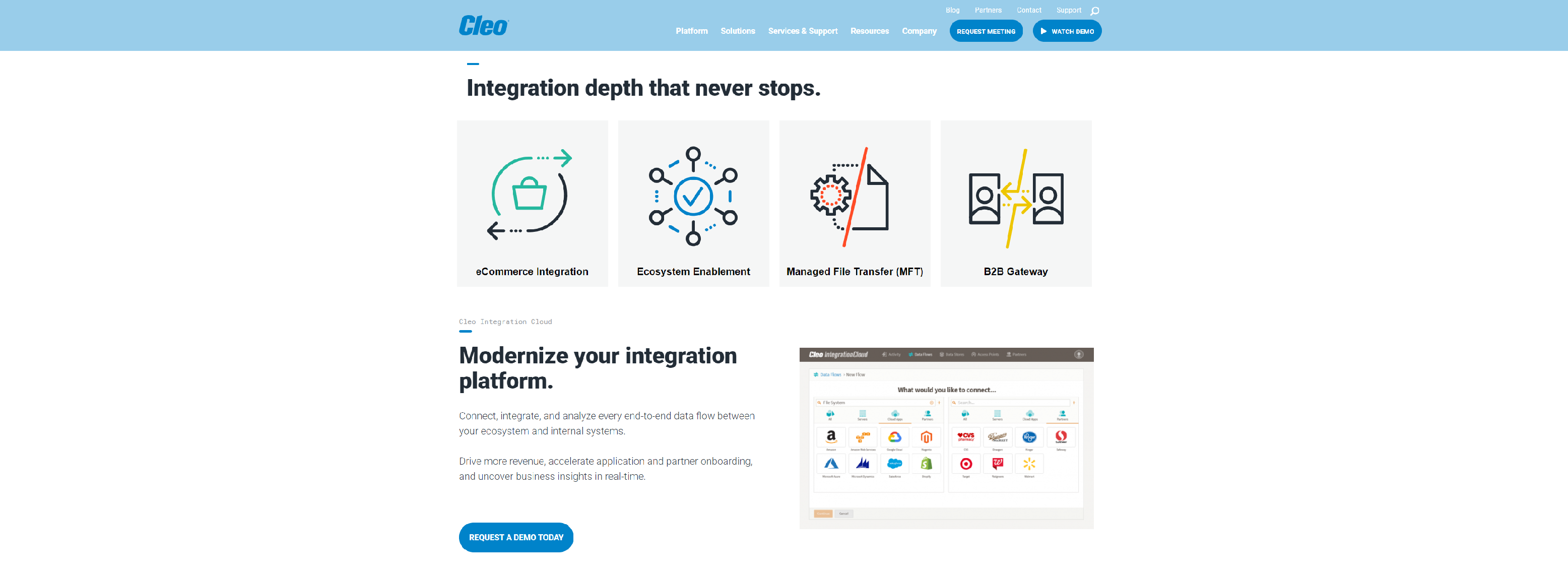
Cleo offers the industry’s most robust integration platform, allowing businesses to easily connect/integrate systems, applications, services, people & processes.
- Accelerate business ecosystem integration
- Modernize your EDI integration
- Expedite partner onboarding
- Browse our Trading Partner Network
- Optimize integration costs
IQMS
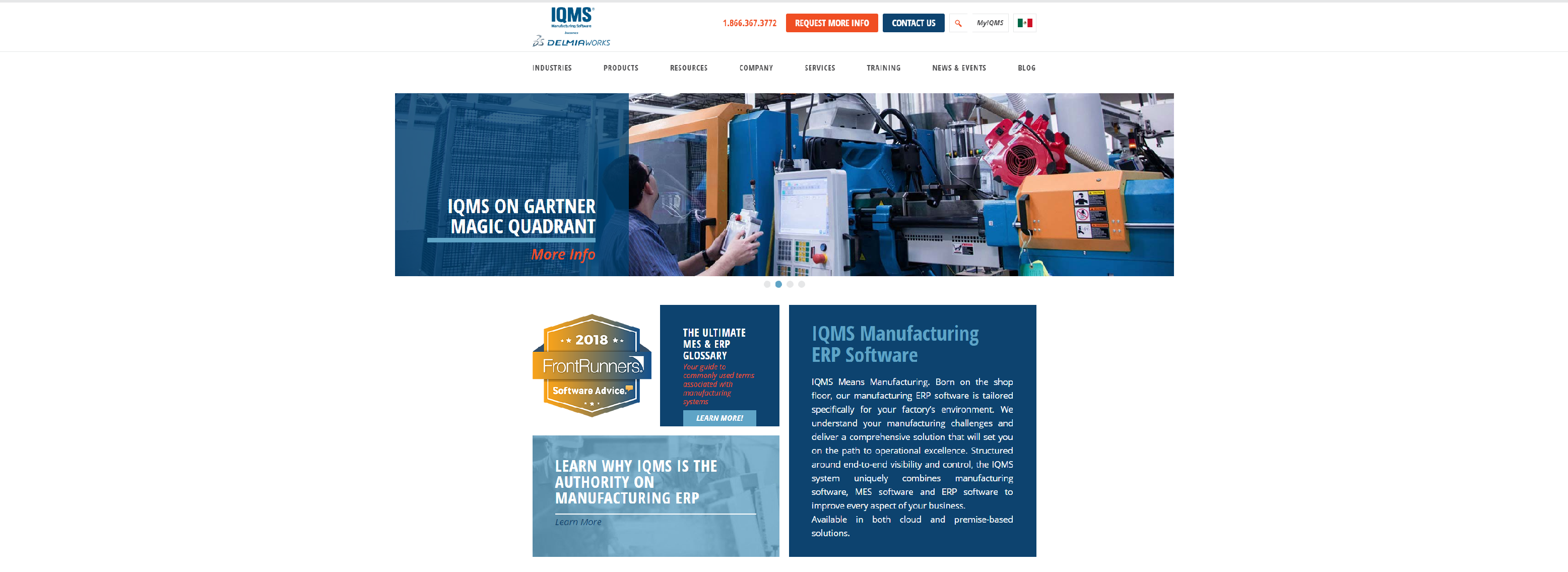
IQMS offers a comprehensive manufacturing, MES and ERP software system to help manufacturers increase efficiency and drive more profitable revenue growth.
- Outbound transactions generated in trading partner format directly from the system
- Business rules generate exception documents to ensure data integrity
- Two-way EDI messages supported for true supply chain functionality
- Accommodates various industries including the AIAG supply chain business practices
- Supports a variety of file formats including: ANSI X.12, EDIFACT, Odette, XML, CSV, VDA, and flat-file
- IQMS EDI VAN eliminates the need for a third party network service providing a single point of contact to manage the complete EDI process including setup, configuration and service (Other EDI VAN networks are also supported)
- Supports FTP transmissions and receipt of files
TRUECOMMERCE

EDI Systems and EDI Software From TrueCommerce – The Industry’s Most Accredited Managed Service EDI Provider By ERP Software Publishers.
- Trading Partner Platform for EDI
- EDI Compliance
- EDI Integration
- Enable Suppliers with EDI
- EDI Support and Professional Services
- E-Invoicing
- Sell Online
- eCommerce and ERP Integration
- Integrated EDI for Your Business System
GLOBALSHOPSOLUTIONS

Global Shop Solutions writes, owns and sells Enterprise Resource Planning (ERP) software to the manufacturing industry.
- Invoices
- Planning schedule with release capabilities
- Purchase order acknowledgment
- Purchase order change request
- Payment order/remittance advice
- Purchase orders
- Advanced shipping notice
- Combination invoice/advanced shipping notice
- Shipping schedule
- Compatible with most third-party solutions
- Simplify customer transactions
- One-time data entry
- Fewer errors and improved accuracy
- Reduced clerical workload and phone time
- Higher productivity without increased staff
- More timely communication
- Uniform communication with trading partners
- Compatible with many EDI solutions
- Rapid exchange of business data
- Reduced inventory safety stocks
- Elimination of mail charges/courier services
- Improved production cycle
- Better market position
- Fully-automated EDI processing available
- Multi-user & multi-location support
WEBEDI
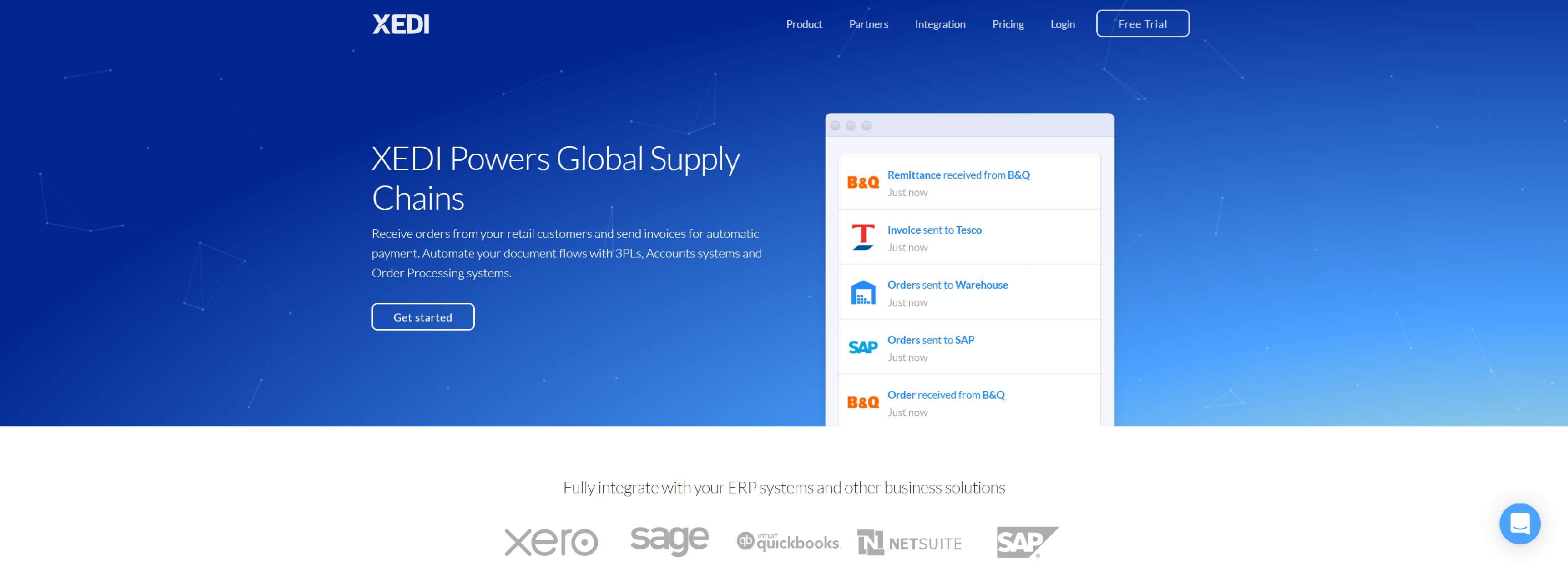
XEDI connects buyers and sellers. Exchange business documents with your trading partners – powered by the industry leading EDI cloud platform.
- Meet the needs of your trading partners
- Forward orders to your warehouse
- Integrate with enterprise solutions
- Fully managed support
EDIFABRIC
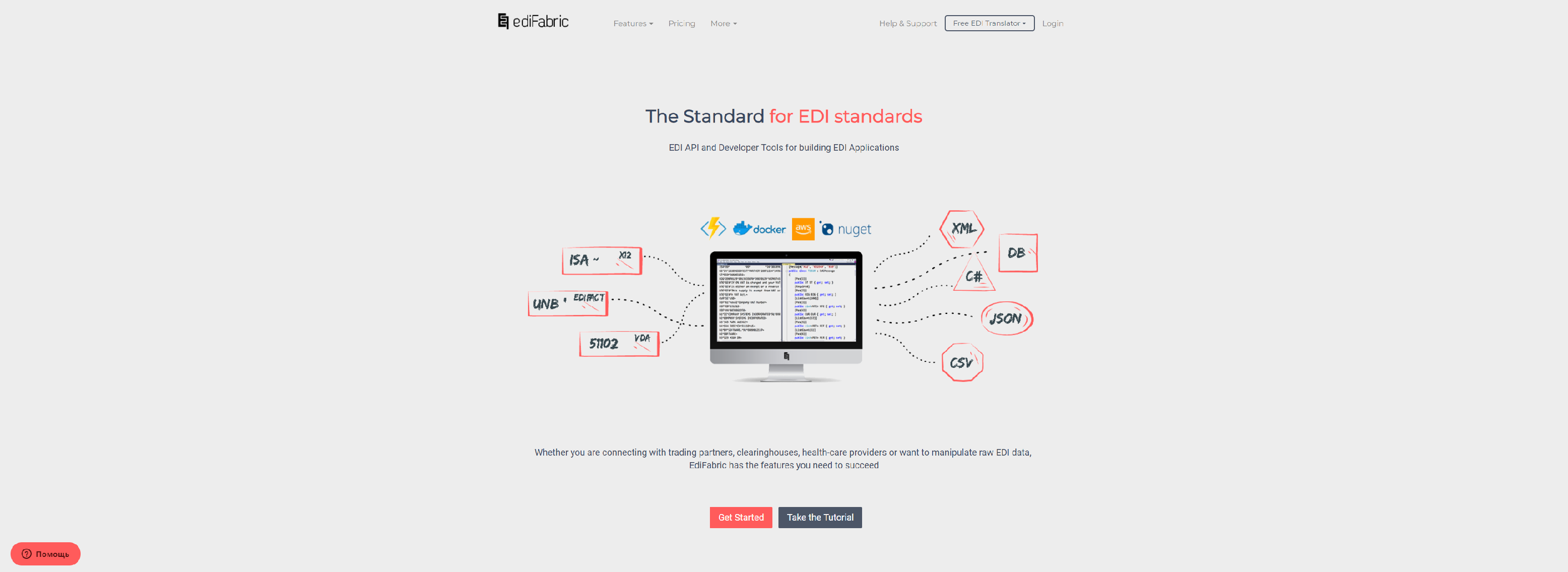
EDI software tools to translate, generate, validate and acknowledge X12, HIPAA, EDIFACT, EANCOM, VDA, PNRGOV.
- One multi-platform EDI Framework for .NET
- Manipulate EDI as an instance of a C# class
- Comply with any EDI format
- All HIPAA 005010 Transactions
ADROITLOGIC
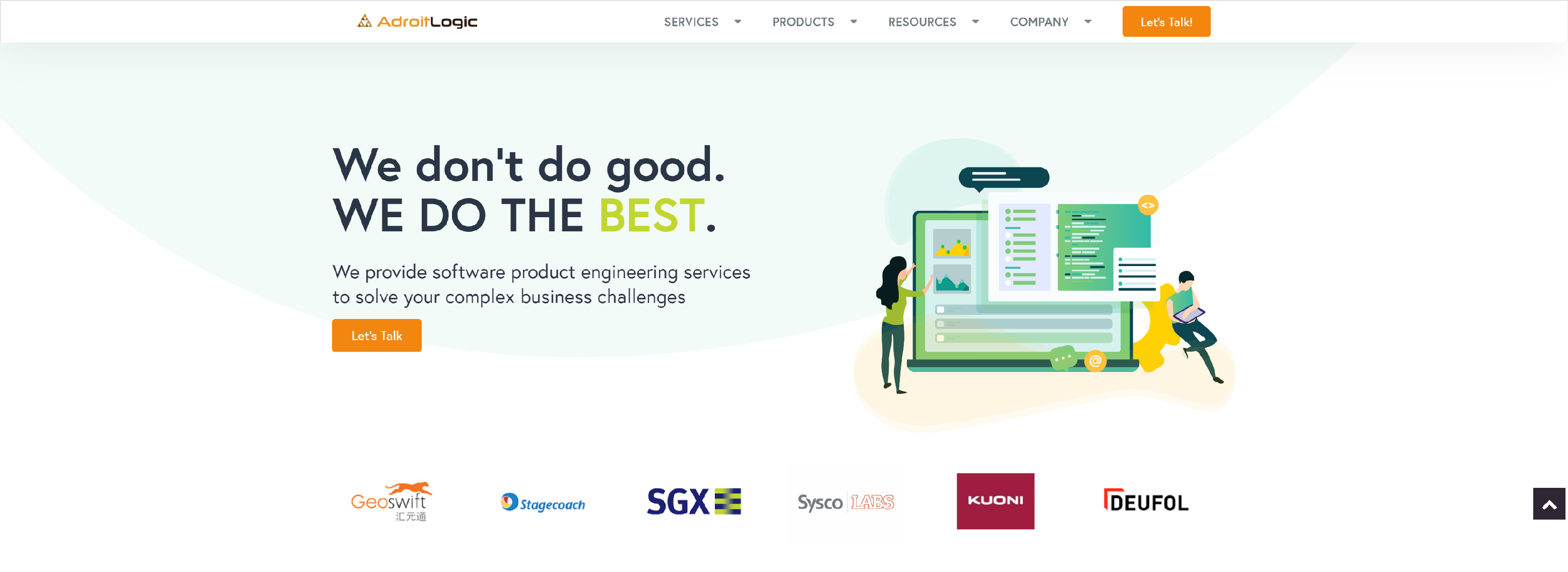
AdroitLogic provides Enterprise Integration and B2B Trading products and services. UltraESB is the core Enterprise Service Bus (ESB that powers some of the largest companies in the world with the best in Performance, Quality and Ease of use and extensibility.
- Build Disruptive Products
- Connect your legacy, on-premise, cloud and hybrid applications together
- Elevate your idea to the Cloud
- Intuitive and user-friendly Solutions
COMPELLO

Compello develops and delivers solutions for EDI, eInvoice and Invoice Approval.
- Import of contact data regardless of source
- Transmission and receipt of EDIFACT/XML messages
- Automatic processes
- Simple to integrate new protocols
- Advanced search engine with the option to search for specific words and content in messages
- SPAM handling
- Web surveillance of transactions/ messages
KLEINSCHMIDT

Kleinschmidt design and support custom cloud-based solutions that enable you to communicate and collaborate on a level playing field with any trading partner imaginable.
- EDI Outsourcing
- EDI Integration
- Data Translation
- Web-Based EDI
- Customs & Trade Compliance
- CLM